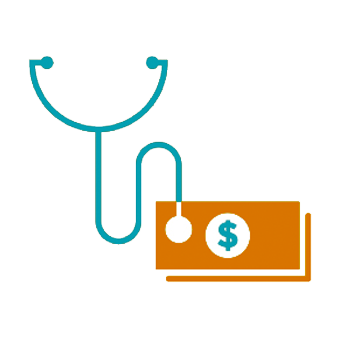View this timeline to see the process Hilltop followed to develop and implement the Hilltop Pre-AH Model.
This chart book, prepared for the Maryland Department of Health, compares the FY 2020 Medicaid reimbursement rates of Maryland and its surrounding states with Maryland’s Medicare fee schedule for CY 2019 for the Baltimore region. The surrounding states included in this study are Washington, DC; Delaware; Pennsylvania; Virginia; and West Virginia. Physician fees comprise three components: physician’s work, practice expense, and malpractice insurance expense.
In 1997, Maryland implemented HealthChoice—a statewide mandatory Medicaid and Children’s Health Insurance Program (CHIP) managed care program—under authority of a waiver through §1115 of the Social Security Act. The provisions of the Affordable Care Act (ACA) that went into effect in 2014 marked another milestone by extending quality coverage to many more Marylanders with low income by calendar year (CY) 2018. Over 20 years after its launch, HealthChoice covered close to 90 percent of the state’s Medicaid and Maryland Children’s Health Program (MCHP) populations.
The Hilltop Institute, on behalf of the Maryland Department of Health (the Department), evaluates the program annually; this evaluation covers the period from CY 2014 through CY 2018.
This chart book—from a series that explores service utilization and expenditures for Medicaid-funded long-term services and supports in Maryland—summarizes data for Autism Waiver participants for fiscal year (FY) 2013 through FY 2017.
This chart book is the second in a series that explores utilization and expenditures for Medicaid-funded long-term services and supports (LTSS) in Maryland for state fiscal years (FYs) 2014 through 2018. The focus of this chart book is on Medicaid HCBS, with one chapter dedicated to illustrating Maryland’s efforts at providing these services to an increasing number of Medicaid recipients who may otherwise be served in institutions. Medicaid programs and services addressed in this chart book include the following: the Home and Community-Based Options (CO) Waiver, Community First Choice (CFC), Community Personal Assistance Services (CPAS), Medical Day Care Services (MDC) Waiver, Money Follows the Person (MFP), and Medicaid nursing facility services.
The Maryland Primary Care Program (MDPCP) is a key element of the Total Cost of Care (TCOC) All-Payer Model, an agreement between the Centers for Medicare & Medicaid Services (CMS) and the state of Maryland. The MDPCP is a voluntary program that provides funding and support for the delivery of advanced primary care throughout the state. It allows primary care providers to play an increased role in the prevention and management of chronic disease, as well as in the prevention of unnecessary hospital utilization.
As an important part of supporting providers in their care management efforts, the MDPCP will provide to participating practices risk scores of their attributed beneficiaries according to each patient’s risk of incurring a potentially avoidable hospitalization or emergency department (ED) visit. Accordingly, The Hilltop Institute, in conjunction with the Maryland Department of Health, has developed the Hilltop Pre-AH (Predicting Avoidable Hospitalizations) Model™ in order to operationalize these risk scores. These patient-level risk scores are provided to participating medical practices on a monthly basis via the MDPCP portal on the Chesapeake Regional Information System for our Patients (CRISP) unified landing page.
This document aims to explain the intended use, technical implementation, and model performance of the Hilltop Pre-AH Model™ as of June 2020. It will be updated as future versions of the model become operational.
DCM interventions improve glycemic control and readmission. Cost effectiveness studies typically use only system EHR data. We implemented a 3-month technology-enabled DCM intervention (Diabetes Boot Camp (DBC)) for adults with uncontrolled T2DM in a regional health system. Using EHR data, DBC was shown to reduce A1C and hospitalizations compared to matched controls. The aim of this study was a TCOC assessment of DBC among Medicaid participants using claims data.
Laura Spicer and Charles Betley were co-authors of this article published in Diabetes.
In response to the nation’s opioid epidemic, an increasing number of states are applying for and receiving Medicaid Section 1115 demonstration waivers for substance use disorders. The Centers for Medicare and Medicaid Services (CMS) created this opportunity under the authority of section 1115(a) of the Social Security Act for states to draw down federal Medicaid payments for facilities with greater than 16 beds that provide short-term residential treatment, which are otherwise prohibited through the Institution for Mental Disease (IMD) exclusion. Waiving the IMD exclusion allows states to offer short-term residential treatment, thereby offering the entire continuum of addiction treatment services to their Medicaid members based on widely accepted standards for evidence-based care.
This research was supported by the Robert Wood Johnson Foundation’s Research in Transforming Health and Health Care Systems program, which is administered by AcademyHealth. Hilltoppers Cynthia Woodcock, Alice Middleton, David Idala, and Matthew Clark co-authored this report, which describes the experiences of two early adopters of IMD waivers, Maryland and Virginia, in terms of their implementation and impact on the addiction treatment system for Medicaid members.
This provides a brief look at the Hilltop Pre-AH Model™, a risk prediction model that uses a variety of risk factors derived from Medicare claims data to estimate the probability that a given patient incurs an avoidable hospital event in the near future. These risk scores are intended to assist Maryland Primary Care Program (MDPCP) practices with the identification of beneficiaries that have a high risk of incurring an avoidable hospitalization or emergency department event. The Pre-AH Model™ risk scores, used in conjunction with provider clinical guidance, can facilitate a more efficient and impactful allocation of practices’ care management resources.
People with dementia (PWD) represent some of the highest-need and highest-cost individuals living in the community. Maximizing Independence (MIND) at Home is a potentially cost-effective and scalable home-based dementia care coordination program that uses trained, nonclinical community workers as the primary contact between the PWD and their care partner, supported by a multidisciplinary clinical team with expertise in dementia care. This study calculated cost of care management services based on actual time spent by care management personnel over the first 12 months of the MIND at Home intervention for 342 MIND at Home recipients from Baltimore, Maryland and surrounding areas participating in a Centers for Medicare and Medicaid Services (CMS)-funded Health Care Innovation Award demonstration project.
Ian Stockwell, PhD, co-authored this article published in Innovation in Aging.





